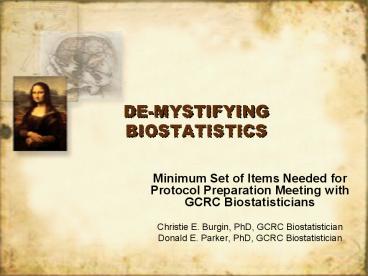DEMYSTIFYING BIOSTATISTICS - PowerPoint PPT Presentation
1 / 21
Title:
DEMYSTIFYING BIOSTATISTICS
Description:
DE-MYSTIFYING BIOSTATISTICS. Minimum Set of Items Needed for Protocol Preparation ... Ordinal (degree of pain, severity of accident, tumor grade) Measurement Variables ... – PowerPoint PPT presentation
Number of Views:57
Avg rating:3.0/5.0
Title: DEMYSTIFYING BIOSTATISTICS
1
DE-MYSTIFYING BIOSTATISTICS
- Minimum Set of Items Needed for Protocol
Preparation Meeting with GCRC Biostatisticians - Christie E. Burgin, PhD, GCRC Biostatistician
- Donald E. Parker, PhD, GCRC Biostatistician
2
Sequence Cycle of Research
- Choosing the research question
- Developing the protocol
- Pretesting and revising the protocol
- Carrying out the study
- Analyzing the findings
- Drawing and disseminating the conclusions
3
Why Plan a Research Project?
- To Avoid Unanticipated Problems!
- Improper assignment of subjects to treatments
- Unexpected large variability among subjects
- Unrealistic schedule for study completion
- Inadequate or no data management
4
The Exercise and Value of Mental Planning
- with colleagues familiar with the research topic
and with related research - with research facilitators
- with a statistical consultant
- with current/recent literature
- with friends
- with family members
- with self
5
Ten Steps for Designing a Study
- Develop a good idea
- Decide on objectives and establish priorities
- Determine the variables required
- Select and describe the study population
- Refine objectives into quantitative addressable
hypotheses or estimates - Anticipate error and bias
- Develop the study design
- Estimate the sample size needed
- Write a research proposal for review
- Plan the data collection
6
Minimum Set of Items to Bring to First Meeting
with Statistician
- General research question(s)
- The design of the study
- Who the subjects will be
- What information (response variables) you wish to
obtain from each subject - Information for sample size/power calculations
7
Developing Research Question(s)
- State the Aim(s) of the research project
- Prioritize (rank) the Aims
- Categorize the Aims
- Primary Aims
- Secondary Aims
- Obtain Feedback on Decisions
- from colleagues
- from self
8
Refining the Research Aims into Quantitative
Expression
- Once the research aims have been written they
need to be refined so that Aims may be addressed
in a quantitative manner.
9
Choosing the Study Design
- Observational Study
(Observing subjects under existing conditions) - Descriptive study
- Analytical study
- Experimental Study
(Random allocation of subjects)
10
Choosing the Study Subjects
- Conceptualize the target population
- The large group of people with a specified set
of characteristics to which the results of the
study will be generalized - Identify an accessible subset of the population
- Sample that will represent the target population
- Design an approach to sampling the population
- Probability sampling
- Nonprobability sampling
- Design approaches to recruiting
- Design contact mechanisms for acquiring a sample
of subjects that is large enough to meet the
study needs, and that has acceptable levels of
technical error and nonresponse bias
11
Defining Response Variables
- Categorical Variables
- Nominal (gender, ethnicity, blood type)
- Ordinal (degree of pain, severity of accident,
tumor grade) - Measurement Variables
- Discrete ( number of cigarettes smoked/day,
number of children in family) - Continuous (weight, blood pressure, cholesterol,
fasting blood sugar)
12
Variables of Interest
13
Variable Time Line
14
Sample Size Techniques for Descriptive
StudiesEstimates for Proportions
- The sample size needed depends on two things
- To what precision you wish to estimate the
proportion - Where in the interval from zero to one the
proportion resides
15
Width of Exact 95 Confidence Intervals for
Sample Sizes 25-500 and Proportion Values 0.5,
0.75 (0.25), 1.00 (0.0)
16
Sample Size Techniques for Descriptive
StudiesEstimates for Means
- The sample size needed depends on two things
- To what precision you wish to estimate the mean
- The standard deviation of the observations from
which mean was obtained
17
Sample Size Precision for 95 Confidence
Intervals about Mean
Sample Precision Size 0.715 10 0.468 20 0.
373 30 0.320 40 0.284 50 0.258 60 0.238 7
0 0.223 80 0.209 90 0.198 100
18
Sample Size Precision for 95 Confidence
Intervals about Mean
19
Power/Sample Size Considerations for
Experimental/Analytical StudiesTests of Means
- The statistical test must be specified
- Researcher must specify the size differences
he/she wants to detect
20
Sample Size/Power for Independent t-test for
Equal Size Groups and Equal Variances Assumed
Standard Units-to convert to study units
multiply standard units by estimate of within
group standard deviation
21
Sample Size/Power for Paired (One Sample) t-test
Standard Units-to convert to study units
multiply standard units by estimate of standard
deviation of differences































